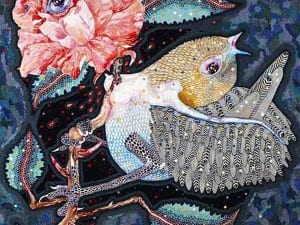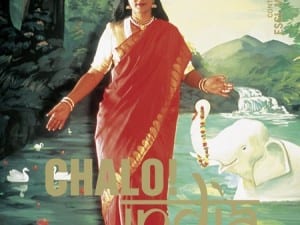The alternate title of the Contemporary African Art Fair is a neat reference to its unification of the continent’s 54 constituent countries. Yet though the titular focus of the fair may be continental, its reach is global: 1:54 sees an astounding geographical array of galleries, from Abidjan to Seattle via Cape Town, meet in London to exhibit their artists. The sense of cultural exchange is almost overwhelming, the proliferation of visual stimuli replicated aurally in the French, Italian and Danish that can be heard drifting along the corridors.
This is the second time that 1:54 has graced the halls of Somerset House, and in the intervening year it has doubled in size. In 2014, 27 galleries spend five days showcasing the work of more than 100 artists – making any criticism of its contents necessarily partial. What can be said of the fair as a whole, however, is its unique offsetting of commerce and criticism, the buzz of the auction house balanced against the calm of the exhibition. Yet it is ultimately this sense of artistic integrity that 1:54 keeps at its core, and reinforces with a series of talks and lectures held at its Forum.
That said, much of the art on display at 1:54 is explicitly concerned with the conditions of its own consumption. Quite often, provocatively so: this is perhaps most clearly the case in the work of the Congolese Sammy Baloji. Part photographer, part collagist, a particularly magnetic works of his exhibited by the Parisian Galerie Imane Farès is the triptych Retour à l’authenticité, vue de la Pagode du Président Mobutu, N’sele, Kinshasa (2013). The piece’s title is bivalent, its “authenticity” standing at once for the autochthony created in the colonial imagination, and indulged by the figure of the naked “tribeswoman”, and for the reality with which Baloji undercuts it, primarily in the image of the dilapidated building.
Yet it is Dan Halter whose work provides the fair’s the most apt metaphor. Zimbabwean born and now living in South Africa, Halter’s Untitled (Fernweh) (translated in the caption as “Farsickness” or “Looking for far-off places”) strikes us an elegant pixelated mess in ink-jet print. At a sufficient distance, however, the piece resolves itself into the following message: “We are sorry, but we don’t have imagery at this zoom level for this region. Try zooming out for a broader look”. The lesson, much as it may not be Halter’s explicit intention, is an important one: that though we must enthusiastically seize what the fair’s organisers describe as “a rare opportunity to explore the rapidly emerging African art market”, we should be wary of Fernweh, of the empty longing for the exotic. The admiration of the art of “far-off places” must not take place from afar, in the hope of resolution into some African “authenticité”. Rather, 1:54 is best appreciated for the very impossibility of its scope, that its component parts can only ever truly be seen in their individual, pixelated beauty.
1:54 Contemporary African Art Fair, 16-19 October, Somerset House, The Strand, London.
Rivkah Brown
Credits
1. Athi-Patra Ruga, The Night of the Long Knives I, 2013, Archival Inkjet Print on Photorag Baryta Paper 150 x 190 cm, Courtesy the artist, WHATIFTHEWORLD.





